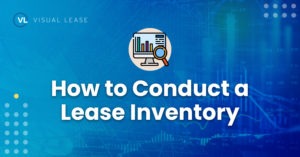
Do you know where all your leases are? If you don’t, chances are you haven’t conducted a lease inventory for your business. Conducting a lease inventory is a standard practice in lease accounting and a very important step in achieving ASC 842 compliance. This process involves finding all your lease data from various departments, which is often a time-consuming cross-functional effort.
What is considered a lease under ASC 842? FASB defines a lease as “a contract or an element of a contract that conveys the right-of-use (ROU) of a physically distinct identified asset for a specified period of time in exchange for payment.” This includes embedded leases which are typically leases that are part of larger contracts. These contracts need to be identified and accounted for on the balance sheet in order to achieve compliance.
However, there is an exemption for short-term leases. These contracts have a lease term of 12 months or less and will not appear on the balance sheet. Additionally, they do not include options to purchase the asset from the lessor.
When it comes time for your audit, auditors want thorough, reliable and accurate data to examine. Completeness is key here, meaning that you’ve properly captured and identified all lease arrangements to be included in your calculations (including embedded leases). This will always be one of the items auditors test, which is why it’s important to conduct a thorough lease inventory.
In this blog, we will share three essential tips to ensure you conduct a thorough lease inventory to support accurate lease accounting. By taking these steps, you will set your business up for lease accounting success and feel confident that you have every lease represented in your lease portfolio.
1. Engage stakeholders from cross-functional departments
To begin the process of conducting a lease inventory, you’ll need to identify what departments have lease contracts. Under ASC 842, leases can range anywhere from property, plant, equipment and even IT assets. Typically, we’ll see Real Estate and Legal departments heavily involved in leases, but there are also departments like IT that have unique lease contracts.
Below are 5 recommended departments you should engage with and the types of leases they most likely handle.
- Accounting/Finance
- This department is a great starting point for conducting a lease inventory as they are the gatekeepers of the prior year’s lease information.
- Real Estate
- The real estate department naturally handles all real estate and property leases, which may include things like office buildings and commercial real estate.
- Procurement
- The procurement department handles all non-real estate leases which can range from vehicles, equipment, furniture and even fixtures.
- Legal
- The legal department reviews all lease arrangements and is a great source of detailed information for embedded leases.
- IT
- This department handles all IT procurement and procures IT assets. This can range anywhere from computers, networks and servers.
2. Organize your leases in one location
Once you’ve gathered all your leases, it’s important to centralize them in one location. The most effective way to do this is by utilizing lease accounting technology. This will allow your cross-functional team to work under the same system and have a comprehensive audit trail for all lease changes. It will also help your team analyze lease data more thoroughly – which can help reduce the risk of overpaying for leases and ultimately help your business save money.
3. Thoroughly check for accuracy and completeness
As your business prepares for ASC 842 compliance, it’s important to examine (and re-examine) your lease contracts thoroughly for accuracy and completeness. Auditors will want to make sure that all transactions have been recorded properly on the balance sheet. It never hurts to double and triple check your work.
In fact, make sure you’ve also cross-referenced all lease contracts with the Accounts Payable department. You could be paying bills for other leases from other departments, which can lead to misreporting.
The outlined steps above should help your business create a smooth process in conducting a lease inventory. Remember, the more accurate your lease portfolio is, the better chance you’ll have in successfully achieving ASC 842 compliance. It will also help significantly decrease the risks of misreporting lease data, which can result in fines, increased audit fees and potential legal action. That’s why conducting a thorough lease inventory is not only important but can also be highly beneficial for your business. Successful lease accounting isn’t just compliance, it’s saving money and creating opportunities to improve business operations, and that all begins with your lease inventory.























